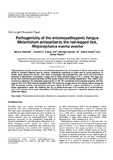Pathogenicity of the entomopathogenic fungus Metarhizium anisopliae to the red-legged tick, Rhipicephalus evertsi evertsi

View/
Date
2011Author
Hedimbi Marius.
Kaaya Godwin P.
Samish GP Michae.
Gindin M Galina.
Glazer Itamar.
Type
ArticleLanguage
enMetadata
Show full item recordAbstract
Rhipicephalus evertsi evertsi is an economically-important tick of livestock in Africa mainly due to its ability to transmit Babesia equi to horses, Anaplasma marginale to cattle and to cause paralysis in lambs, adult sheep and calves. This study investigated the pathogenicity and hence the bio-control potential of Metarhizium anisopliae to eggs and all other off-host stages of R. e. evertsi. The eggs and larvae were infected by placing them on filter paper wetted with conidial suspension. Tick instars were infected by dipping in M. anisopliae suspenssion (1×103–108 conidia/ml) and incubated together with the eggs at 25°C and 100% relative humidity (RH). The mortality of eggs and all tick stages tested increased with increasing conidial concentration and were higher (P>0.05) in conidia formulated in oil than in those formulated in water. For instance, the LC50 in unfed larvae was 1×104 conidia /ml in oil formulation and 1×105 conidia /ml in water formulation. No difference was observed in mortality between fed and unfed tick stages.
URI
http://www.academicjournals.org/JEN/abstracts/abstracts/abstracts2011/July/Hedimbi%20et%20al.htmhttp://erepository.uonbi.ac.ke:8080/xmlui/handle/123456789/37372
Citation
Journal of Entomology and Nematology Vol. 3(7), pp. 68–72, July 2011Publisher
University of Nairobi. school of Biological Sciences
Subject
Rhipicephalus evertsi evertsiMetarhizium anisopliae
formulation
mortality
biological control
